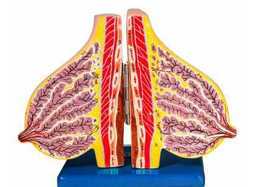رَبِّ زِدْنِي عِلْماً

MAMMARY GLAND IN LACTATION
Embryology
₹82.00₹22.00
The mammary gland, a specialized glandular structure found in mammals, plays a critical role in lactation, the process of producing and secreting milk. This vital adaptation not only supports the nutritional needs of infants but also contributes significantly to their immune system development and overall health. Understanding the anatomy, physiology, and hormonal regulation of the mammary gland during lactation reveals the intricate processes that enable successful breastfeeding. Anatomically, the mammary gland is composed of lobes, lobules, and ducts. Each lobe contains smaller lobules, which are clusters of alveoli, the sac-like structures where milk is produced. These alveoli are lined with milk-secreting epithelial cells and are embedded in a supportive matrix of connective tissue and adipose tissue. Milk is transported from the alveoli through a network of ducts that converge at the nipple, allowing for the efficient delivery of milk to the nursing infant. The physiological process of lactation is initiated during pregnancy, influenced by a complex interplay of hormones. Key hormones include prolactin, oxytocin, and estrogen, each playing distinct roles in the development of the mammary gland and the production of milk. Prolactin, produced by the anterior pituitary gland, is fundamental for the synthesis of milk proteins and fat, while estrogen prepares the mammary tissue for lactation by promoting ductal growth. Concurrently, oxytocin, released from the posterior pituitary gland, facilitates milk ejection during breastfeeding by stimulating the contraction of myoepithelial cells surrounding the alveoli. At the onset of lactation, typically a few days after childbirth, the initial milk produced is known as colostrum. Rich in immunoglobulins, lactoferrin, and other essential nutrients, colostrum serves as a protective shield for the newborn, helping to establish a healthy gut microbiome and boosting the infant's immune responses. As lactation progresses, mature milk is produced, which is characterized by a balance of carbohydrates, proteins, and fats tailored to the growing infant's needs. The demand for milk is regulated through a supply-and-demand mechanism known as feedback inhibition. When an infant suckles at the breast, the stimulation of nerve endings in the nipple sends signals to the hypothalamus and pituitary gland, triggering the release of prolactin and oxytocin. This not only promotes milk production but also facilitates the letdown reflex, allowing the milk to flow. The frequency and intensity of breastfeeding dictate the volume of milk produced, as the mammary gland adjusts to meet the infant's needs. Breastfeeding comes with a host of benefits for both mother and child. For infants, breastfeeding is associated with lower risks of infections, obesity, diabetes, and allergies, among other health issues. For mothers, lactation helps in postpartum recovery, reduces the risk of certain cancers, and strengthens the mother-infant bond. Public health initiatives continue to advocate for exclusive breastfeeding for the first six months of life to promote optimal health. However, some women may face challenges in initiating or maintaining lactation. Factors such as hormonal imbalances, stress, or medical conditions can affect milk production. Support from healthcare professionals, lactation consultants, and support groups is crucial for helping mothers overcome these obstacles and achieve their breastfeeding goals. In conclusion, the mammary gland's role in lactation is a sophisticated physiological process that exemplifies the delicate balance of hormonal interactions and anatomical adaptations. By efficiently providing essential nutrition and immunological protection to infants, lactation illustrates a fundamental aspect of maternal care in mammals, underscoring the importance of supporting breastfeeding for promoting health across generations.
Training
Providing essential healthcare training and simulation solutions.
COntacts
Support
info@medisureinternational.com
+91 9972123423
© Medisure. All Rights Are Reserved
Crafted with ❤️by Influence Kashmir
